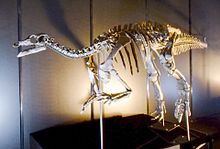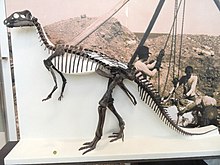Camptosaurus
| Camptosaurus | |
|---|---|

| |
| Reconstructed skeleton in Japan | |
| Scientific classification | |
| Domain: | Eukaryota |
| Kingdom: | Animalia |
| Phylum: | Chordata |
| Clade: | Dinosauria |
| Clade: | †Ornithischia |
| Clade: | †Ornithopoda |
| Clade: | † Dryomorpha
|
| Clade: | †Ankylopollexia |
| Superfamily: | †Camptosauroidea Marsh, 1885 |
| Family: | †Camptosauridae Marsh, 1885 |
| Genus: | †Camptosaurus Marsh, 1885 |
| Type species | |
| Camptonotus dispar Marsh, 1879
| |
| Other species | |
| |
| Synonyms | |
| |
Camptosaurus (
History of discovery

On September 4, 1879

Then in 1980,
Camptosaurus depressus was recovered from the

While Marsh was describing Camptosaurus species in North America, numerous species from Europe were also referred to the genus in the late 19th and early 20th centuries: C. inkeyi, C. hoggii, C. leedsi, C. prestwichi, and C. valdensis. C. inkeyi (Nopcsa, 1900) consists of fragmentary material, a dentary and articular from Upper Cretaceous rocks of the
The remaining European species Camptosaurus prestwichii was recovered from Chawley Brick Pits,
In 2022, the first confirmed European remains belonging to aff. Camptosaurus .sp were described by Sánchez-Fenollosa et al..[1] A single specimen was found in the Fuentecillas member of the Villar del Arzobispo Formation in Spain, consisting of an anterior cervical centrum; an anterior dorsal centrum; a dorsosacral centrum; four sacral centra; a caudosacral centrum; two anterior caudal centra; three medial caudal centra; and a distal fragment from the left humerus. The Fuentecillas specimen is seen to be closer to Camptosaurus than to Draconyx from the Jurassic of Portugal,[18] hence its tentative placement within the Camptosaurus genus.[1]
Description

Camptosaurus is a relatively heavily built form, with robust hindlimbs and broad feet, still having four toes.[4] Due to the separate status of Uteodon it has become problematic which material from the Morrison Formation belongs to Camptosaurus. The specimens with certainty belonging to Camptosaurus dispar, from Quarry 13, have been recovered from very deep layers, probably dating to the Callovian-Oxfordian.[10] The largest fragments from later strata indicate adult individuals around 6.79 metres (22.3 ft) long.[19] The Quarry 13 individuals are smaller though. They have been described as reaching 6 meters (19.7 feet) in length and 785 – 874 kg in weight.[20] In 2010 Gregory S. Paul gave an even lower estimate: a length of five metres and a weight of half a tonne.[21]
Earlier reconstructions, such as those by Marsh and Gilmore, were based on the skull of Theiophytalia and display an incorrect, more rectangular profile. The skull was in fact triangular with a pointed snout, equipped with a beak. Its teeth were more tightly packed in the jaw compared to other Morrison euornithopods.[20] Museum curator John Foster describes them as having "thick median ridges on their lateral sides and denticles along their edges," these features were similar to, but "more fully developed" than those in Dryosaurus.[20] Camptosaurus teeth frequently exhibit extensive wear, which indicates that individuals in the genus had a diet of relatively tough vegetation.[20]
Classification
Marsh in 1885 assigned Camptosaurus to a family of its own: the Camptosauridae. Alternatively some authors considered it an early member of the Iguanodontidae.
Modern phylogenetics has made Camptosaurus by definition part of the clade Ankylopollexia, of which group it would then be a basal member. This would mean that the genus is closely related to the ancestor of later
In the 2010 and 2011
| Ankylopollexia |
| ||||||||||||||||||||||||||||||||||||||||||
Paleobiology

Based on studies of other iguanodonts (clade Iguanodontia), scientists believe they may have been able to achieve running speeds of 25 km per hour (15 mph).[20] A tiny 9 inch fossilized embryo, referred to Camptosaurus, was retrieved from Morrison Formation strata at Dinosaur National Monument in Utah.[20]
See also
- List of dinosaurs
- Paleobiota of the Morrison Formation
References
- ^ S2CID 245804125.
- S2CID 131001110.
- ^ Marsh, O.C. (1885). "Names of extinct reptiles". American Journal of Science. 29: 169.
- ^ a b c Galton, P.M.; Powell, H.P. (1980). "The ornithischian dinosaur Camptosaurus prestwichii from the Upper Jurassic of England". Palaeontology. 23: 411–443.
- ^ Bakker, R.T. (1998). "Dinosaur mid-life crisis: the Jurassic-Cretaceous transition in Wyoming and Colorado". In Lucas, S.G.; Kirkland, J.I.; Estep, J.W. (eds.). Lower and Middle Cretaceous Terrestrial Ecosystems. Vol. 14. New Mexico Museum of Natural History and Science Bulletin. pp. 67–77.
- S2CID 130777820.
- ^ .
- ^ Foster, J. (2007). "Appendix." Jurassic West: The Dinosaurs of the Morrison Formation and Their World. Indiana University Press. pp. 327-329.
- ISBN 978-0-253-34817-3.
- ^ S2CID 86197297.
- ^ PMID 21124919.
- ^ .
- .
- ^ a b Galton, Peter M. (2009). "Notes on Neocomian (Late Cretaceous) ornithopod dinosaurs from England - Hypsilophodon, Valdosaurus, "Camptosaurus", "Iguanodon" – and referred specimens from Romania and elsewhere". Revue de Paléobiologie. 28 (1): 211–273.
- ISBN 978-0-253-34817-3.
- ^ Norman D.B. and Barrett, P.M. 2002. Ornithischian dinosaurs from the Lower Cretaceous (Berriasian) of England. Palaeontology 68:161-189
- ISBN 978-0-412-62040-9.
- .
- .
- ^ a b c d e f g Foster, J. (2007). "Camptosaurus dispar." Jurassic West: The Dinosaurs of the Morrison Formation and Their World. Indiana University Press. p. 219-221.
- ^ Paul, G.S., 2010, The Princeton Field Guide to Dinosaurs, Princeton University Press p. 284
- PMID 21124919.
External links
![]() Media related to Camptosaurus at Wikimedia Commons
Media related to Camptosaurus at Wikimedia Commons
